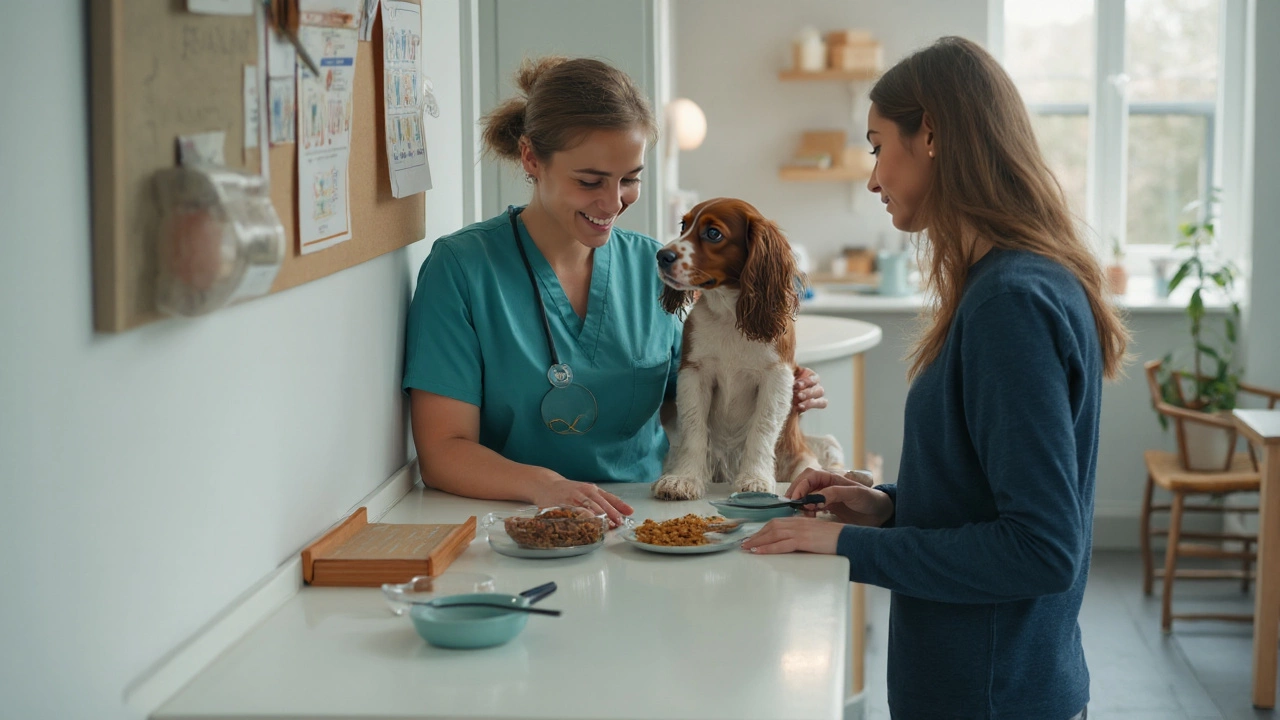You want a straight answer without the sales gloss. Is Nutro solid nutrition or just nice packaging? Short version: Nutro is a dependable mid-range brand backed by Mars Petcare quality control and research. It fits most healthy dogs, especially if you stick with their grain-inclusive recipes. But if your dog needs therapeutic nutrition, ultra-high protein, or exact veterinary guidance, there are better fits.
TL;DR: Is Nutro good for dogs?
Here’s the quick verdict people actually want when they search is Nutro good for dogs:
- Yes-Nutro is a safe, mid-range choice for most healthy dogs. It’s made by Mars Petcare, meets AAFCO profiles, and has transparent ingredient lists.
- Best for: adult pets with normal activity, puppies in the Natural Choice life-stage formulas, and dogs needing simple recipes (Limited Ingredient line).
- Not the best for: dogs needing veterinary diets (e.g., GI, kidney), canine athletes needing very high protein/energy, or pets with multiple protein allergies (Ultra mixes several proteins).
- Safety: A handful of isolated recalls over the past 15 years (e.g., small wet food lots for foreign material). No FDA dog food recalls for Nutro noted in 2023-2025 at the time of writing (FDA recall database, accessed Sept 2025).
- DCM/grain-free: If you don’t need grain-free for a medical reason, pick Nutro’s grain-inclusive formulas. The FDA’s 2022 update hasn’t established a causal link, but it’s sensible to avoid legume-heavy diets unless your vet says otherwise.
Quality, ingredients, and safety: what you should know
Who makes Nutro? Mars Petcare (same parent company as Royal Canin and IAMS). Mars operates large U.S. facilities and runs the Waltham Petcare Science Institute, which publishes peer-reviewed research. That scale matters-bigger companies tend to have tighter supplier controls, in-house testing, and more consistent quality assurance.
Ingredients and nutrition philosophy. Nutro leans into “natural” positioning: named animal proteins (chicken, lamb, salmon), meat meals for amino acid density, and grain-inclusive recipes that use brown rice, barley, and oats. They avoid chicken by-product meal, corn, wheat, and soy in their core lines and market “non-GMO ingredients.” You’ll see common functional add-ins like beet pulp (fiber/prebiotic), fish oil (omega-3s), glucosamine (joint support in some large-breed formulas), and chelated minerals for absorption.
Protein and energy levels. Most adult Nutro kibbles sit around 22%-26% protein and 12%-15% fat, with roughly 340-380 kcal/cup. That’s appropriate for average adult dogs. Ultra nudges protein and fat a bit higher. If your dog is a working athlete or needs aggressive weight gain, you might want a more energy-dense food.
AAFCO compliance. Nutro recipes carry AAFCO nutritional adequacy statements for life stage (growth-including large-breed growth-maintenance, or all life stages). Look for the exact statement on the bag. AAFCO updated dog nutrient profiles in 2023; brands have a transition window. Expect labeling to reflect those updates across 2025-2027.
Recalls and transparency. According to the FDA’s pet food recall archive (reviewed Sept 2025), Nutro has had a few recalls across the last decade and a half-generally limited lots, often wet foods, typically for potential foreign material. No Nutro dog food recalls were posted in 2023-2025 at press time. Recalls happen to most big brands at some point; what matters is speed, scope, and corrective action.
DCM context (grain-free diets). The FDA’s ongoing review (2018-2022 updates) hasn’t proved a causal link between grain-free diets and dilated cardiomyopathy, but many vets still play it safe with grain-inclusive foods unless there’s a documented need for grain-free. If you use Nutro’s grain-free, pick recipes where pulses (peas, lentils) aren’t dominating the ingredient list and talk with your vet if your dog has risk factors for DCM.
WSAVA Global Nutrition Committee: “The most important factor in selecting a pet food is the manufacturer. Brands should employ a full-time qualified nutritionist, conduct and publish research, and have robust quality control for ingredients and finished products.” (WSAVA GNC, Selecting a Pet Food Toolkit)

Which Nutro line fits your dog?
Nutro’s naming can feel like a grocery aisle maze. Here’s how to pair a line with your dog’s needs.
- Natural Choice (grain-inclusive): The workhorse line. Puppy, adult, and senior options; small- and large-breed versions; healthy weight formulas. Good default for most dogs. Typical protein ~22%-26%.
- Ultra (grain-inclusive, multi-protein): Chicken + lamb + salmon with a “superfood” mix. Slightly higher protein/fat than Natural Choice and more flavor variety-nice for picky eaters. Not ideal for dogs with suspected protein allergies because it combines multiple proteins.
- Limited Ingredient Diet (often grain-free; check label): Single animal protein (like lamb, salmon) with fewer total ingredients. Useful for elimination trials or sensitive stomachs. If you want to avoid grain-free, look for limited-ingredient recipes that include grains (availability varies by market).
- So Simple (wet toppers and mixers): Short ingredient lists to boost palatability. Some are supplemental (not “complete and balanced”). Read the AAFCO statement-if it says “intermittent or supplemental feeding,” don’t use it as the sole diet.
Quick pairing by scenario:
- Healthy adult, average activity: Natural Choice Adult Chicken & Brown Rice (size-specific if needed).
- Puppy: Natural Choice Puppy; pick large-breed puppy for projected adult weight ≥70 lb for controlled calcium.
- Picky eater or higher flavor variety: Ultra Adult.
- Suspected food sensitivity: Limited Ingredient Diet with a novel protein your dog hasn’t eaten before. Confirm AAFCO “complete and balanced.”
- Senior dog with stiff joints: Natural Choice Senior; consider a vet-approved omega-3 supplement if not already included.
| Product (example) | Type | Primary ingredients | Protein % | Fat % | Fiber % | Energy | Typical price (2025) | Best for |
|---|---|---|---|---|---|---|---|---|
| Natural Choice Adult Chicken & Brown Rice | Dry kibble | Chicken, chicken meal, brown rice, barley | 22 | 14 | 3.5 | ~350 kcal/cup | $1.90-$2.40/lb | Most healthy adult dogs |
| Ultra Adult | Dry kibble | Chicken, chicken meal, lamb meal, salmon meal, oats | 26 | 15 | 4.0 | ~360 kcal/cup | $2.60-$3.20/lb | Picky eaters; extra flavor and variety |
| Limited Ingredient Diet Lamb & Sweet Potato | Dry kibble | Lamb, lamb meal, sweet potato (check grain status) | 20 | 14 | 3.5 | ~350 kcal/cup | $2.80-$3.60/lb | Sensitive stomachs; simple formula |
| Natural Choice Large-Breed Puppy | Dry kibble | Chicken, chicken meal, whole grains | 26 | 14 | 4.0 | ~360 kcal/cup | $2.20-$2.80/lb | Growth with controlled minerals |
| Ultra Wet (12.5 oz can) | Wet food | Chicken, lamb, salmon, broth, veggies | 8 (as-fed) | 5 (as-fed) | 1 (as-fed) | ~350 kcal/can | $2.70-$3.50/can | Meal topper; palatability |
Notes: Values are typical examples-always check your exact bag or can. Wet food percentages are “as fed” and aren’t directly comparable to dry; you’d need to convert to dry matter for a fair comparison.
Nutro vs popular alternatives: how it stacks up
Here’s the context you need to decide if Nutro is a fit or if another brand suits your dog better.
- Purina Pro Plan: Extensive clinical research, many targeted formulas (sensitive skin & stomach, sport, livestock protein options), and strong QA. Often the pick for performance dogs or complex GI/skin cases. Taste can be hit-or-miss for picky eaters. Price ranges from mid to premium depending on subline.
- Hill’s Science Diet: Predictable, tightly formulated, and backed by veterinary nutritionists. Excellent for weight management and sensitive stomach/skin lines. Flavor variety is narrower. Strong choice for seniors and dogs needing specific macro control.
- Blue Buffalo: Similar “natural” positioning to Nutro with more grain-free choices and pieces like LifeSource Bits. Recipe variety is high. QA has improved, but choose mainstream lines and read labels-watch legume-heavy recipes if you’re DCM-cautious.
- Wellness (Complete Health/Core): Solid natural brand with higher-protein options (Core). Good for active dogs who need more protein while staying grain-inclusive. Price trends a bit higher than Nutro.
Quick “best for / not for” snapshot:
- Choose Nutro if you want a clean, grain-inclusive formula with named proteins for a healthy pet, especially if your dog likes straightforward flavors.
- Choose Pro Plan or Hill’s if you need tight clinical targeting (GI, renal, weight) or you value brands with the widest research base and veterinary lines.
- Choose Wellness Core if you want higher protein while staying grain-inclusive.
- Consider Limited Ingredient options (Nutro LID or Pro Plan Sensitive) if you’re working through food sensitivities with your vet.
Decision rule of thumb: if your dog is healthy and you want simple, Nutro Natural Choice is a safe landing. If you’re troubleshooting a medical issue, start with your vet and look hard at Pro Plan or Hill’s targeted formulas.

How to choose, switch, and troubleshoot + Mini‑FAQ
Use this quick plan to pick the right Nutro recipe and make the change with minimal tummy drama.
Step-by-step: pick and switch
- Confirm life stage and size. Puppy vs adult vs senior; small vs large-breed. Match the bag’s AAFCO statement to your dog’s life stage.
- Scan the first five ingredients. Look for a named animal protein (e.g., chicken) and whole grains if you’re going grain-inclusive. Avoid recipes where peas/lentils dominate unless there’s a dietary reason.
- Check energy and feeding chart. Compare kcal/cup to what you feed today. Start at the low end of the feeding range and adjust by stool quality and body condition.
- Transition slowly: 7-10 days. 75/25 old:new for 2-3 days, 50/50 for 2-3 days, 25/75 for 2-3 days, then 100% Nutro. Stretch to 14 days for sensitive stomachs.
- Monitor. Log stool (1-5 scale), itch, energy, and appetite for two weeks. Small soft stools are normal during change; persistent diarrhea or vomiting means call your vet.
Checklist: picking the right Nutro bag
- AAFCO statement matches your dog’s life stage (growth, including large-breed growth if needed; adult maintenance; or all life stages).
- Named protein first; simple recipe if you’re tracking sensitivities.
- Grain-inclusive by default unless your vet recommends grain-free.
- Calories per cup close to your dog’s needs; adjust portions, not just the bag size.
- Fresh expiration date; intact bag; store in an airtight container in a cool, dry place.
Pitfalls to avoid
- Switching too fast. Most GI upsets come from rushing the transition.
- Reading “as-fed” wet food protein as if it equals kibble-convert to dry matter to compare.
- Assuming “grain-free” equals “better.” It’s only “better” if your dog needs it.
- Ignoring the AAFCO adequacy statement on toppers-some are supplemental only.
Mini‑FAQ
- Is Nutro made in the USA? Yes, Nutro is produced in Mars Petcare-owned U.S. facilities with a mix of domestic and imported ingredients, per company disclosures.
- Has Nutro been recalled? Yes, isolated recalls have occurred (e.g., select wet foods for foreign material). No Nutro dog food recalls listed by the FDA in 2023-2025 as of Sept 2025. Always check the FDA recall page and the brand’s newsroom.
- Does Nutro meet AAFCO? Yes. Nutro formulas carry AAFCO nutritional adequacy statements for the labeled life stage.
- Is Nutro grain-free? Some lines/recipes are; many are grain-inclusive. If you don’t have a medical reason to go grain-free, grain-inclusive is a sensible default.
- Does Nutro use by-products? Nutro core lines do not use chicken by-product meal; you’ll see named meat meals instead.
- Good for allergies? There’s no single “allergy food.” For food sensitivities, try Nutro’s Limited Ingredient Diet with a novel protein, but do it under vet guidance, especially if you’re conducting an elimination trial.
- How about DCM risk? The FDA hasn’t established causality. If you’re worried, choose grain-inclusive, keep pulses lower in the ingredient list, and discuss with your vet if your breed has known cardiac risks.
- Price/value? Mid-range. Expect roughly $55-$95 for large bags depending on line and retailer; cans around $2.70-$3.50. Prices vary by size, region, and promotions.
Next steps & troubleshooting
- Soft stool after switching: Pause at the current mix for 2-3 extra days, add a bland topper (plain pumpkin, 1-2 tsp for small dogs; 1-2 tbsp for medium/large), and ensure you’re not overfeeding.
- Itchy skin persists: Rule out fleas/environmental triggers first. If food-related, trial a single-protein Limited Ingredient recipe for 8-12 weeks with no other treats. If no improvement, ask your vet about a hydrolyzed protein veterinary diet.
- Picky eater: Try Ultra for extra aroma, or warm a spoonful of wet food/toppers. Feed on a schedule, not free-choice.
- Weight creeping up: Switch to Natural Choice Healthy Weight, drop treats to ≤10% of daily calories, and recheck portions using a kitchen scale.
- Active dog losing weight: Consider higher-energy options (Ultra or a performance formula from another brand) and split calories into 2-3 meals.
Credibility notes: Product and safety context informed by AAFCO nutrient profiles (2023 update), FDA pet food recall records (accessed Sept 2025), FDA’s DCM updates (latest 2022 communication), and WSAVA Global Nutrition Committee recommendations on choosing pet foods. For medical issues, your veterinarian is the call you make first.
